Book review: The Studio Recordings of the Miles Davis Quintet, 1965-68, By Keith Waters. New York: Oxford Univ. Press, 2011.
Unlocking the Mysteries of the Second Miles Davis Quintet
Best Sheet Music download from our Library.
The Studio Recordings of the Miles Davis Quintet, 1965-68 examines six studio recordings—E.S.P., Miles Smiles, Sorcerer, Nefertiti, Miles in the Sky, and Filles de Kilimanjaro—of the Miles Davis “second quintet.” The group featured Wayne Shorter (tenor saxophone), Herbie Hancock (piano and keyboards), Ron Carter (bass), and Tony Williams (drums).
It is difficult to overstate the importance of this group, both as an ensemble and as a collection of individual players and composers, to the evolution and current state of jazz, as well as to other aspects of contemporary popular music. From a strictly personal perspective, when I think of the most significant jazz recordings and groups in the last fifty years, the first two that come to my mind, are the John Coltrane quartet and this version of the Miles Davis quintet.

Miles is Miles—throughout his career restlessly and relentlessly pushing himself and everyone else through extensive changes in approaches to jazz soloing, band leading, and composing. Hancock and Shorter, both as players and composers, have been major forces and continue to move music forward in numerous ways; Carter has long been one of jazz’s top bassists and bandleaders; and Williams helped shape modern jazz drumming.
Keith Waters, in his understated and self-effacing fashion, sets out his goals in his preface: “The analyses presented here…merely explore ideas that may be of particular interest to jazz musicians, listeners, writers, historians, and analysts, present features of the music that I think are audible but may not be immediately apparent, and consider ways in which these recordings broached or broke with jazz traditions”. These are anything but modest goals, considering the intricate, elusively mysterious, and even magical quality of these recordings—certainly among the most important records in jazz.
Waters listens to the music from an analyst’s point of view of course, but also as an experienced jazz pianist. This enables him to make fascinating and illuminating observations regarding performance-oriented issues, such as the form being lost and found during solos, incorrect entrances, and clashing chords. These touches give us a more direct connection with the music and the musicians and add spice to the analyses.
Browse in the Library:
| Artist or Composer / Score name | Cover | List of Contents |
|---|---|---|
| Autum Song (October) – Tchaikovsky The Seasons (Musescore File).mscz | ||
| Autumn In New York (Guitar Arr. With Tab) | Autumn In New York (Guitar Arr. With Tab) | |
| Autumn In New York (Guitar Arr.) (Musescore File).mscz | ||
| Autumn Leaves Joseph Kosma Jazz Standard Piano Solo arr |
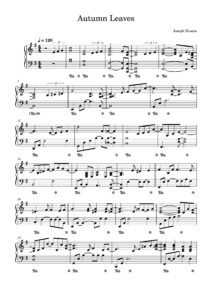 |
|
| Autumn Leaves Joseph Kosma Jazz Standard Piano Solo arr.mscz | ||
| Autumn Leaves Piano Bar Arr. Johnny Mercer Joseph Kosma Jacques André Marie Prévert | Autumn Leaves Piano Bar Arr. Johnny Mercer Joseph Kosma Jacques André Marie Prévert | |
| Autumn Leaves – Jazz Play Along LEAD SHEET MUSIC |
 |
Audio MP3 included in Aebersold’s Vol. 44 (Autumn Leaves) |
| Autumn Leaves – Piano Bar Arr. Johnny Mercer Joseph Kosma Jacques André Marie Prévert (Musescore File).mscz | ||
| Autumn leaves (Eva Cassidy) | ||
| Autumn Leaves As Played By Bill Evans (Musescore File).mscz | ||
| Autumn Leaves Cannonball Adderley And Miles Davis Sax Alto |
 |
|
| Autumn Leaves Music by Joseph Kosma |
 |
|
| Autumn Leaves Piano Solo – as played by Hank Jones.mscz | ||
| Autunm Leaves (Musescore File).mscz | ||
| Avatar – Leona Lewis – I See You |
|
Avatar I see you |
| Avatar sheet music Book James Horner |
|
Avatar |
| Ave Maria (Joyeux Noël OST) Philippe Rombi | ||
| Avenged Sevenfold Nightmare Guitar TAB |
 |
Avenged Sevenfold Nightmare Guitar TAB |
| Avenue Q The Musical Songbook |
 |
Avenue Q The Musical Songbook |
| Avicii – Wake Me Up Sheet Music Piano Vocal Guitar chords |
 |
|
| Avishai Cohen Songbook Vol I |
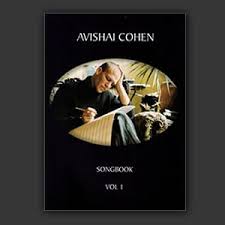 |
Avishai Cohen Songbook Vol I  |
| Avril Lavigne – Complicated | ||
| Avril Lavigne – Freak Out | ||
| Avril Lavigne – Im With You | ||
| Avril Lavigne – Innocence | ||
| Avril Lavigne – My Happy Ending | ||
| Avril Lavigne – When Youre Gone | ||
| Avril Lavigne – Why | ||
| Avril Lavigne the Best Damn Thing Songbook |
 |
Avril Lavigne the Best Damn Thing Songbook |
| Avril Lavigne Under My Skin |
 |
Avril Lavigne Under My Skin |
| Awaken (Jane Eyre OST 2011) Dario Marianelli | ||
| Awakenings Dexter’s Tune by Randy Newman |
 |
|
| Away In A Manger – Guitar TABlature |
 |
|
| Axel F from Beverly Hills Cop b Harold Faltermeyer Piano Vocal Guitar Chords sheet music |
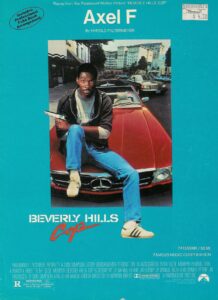 |
|
| Axel Jorgensen ROMANCE for Trombone and Piano Op. 21 |
 |
|
| Aya Hirano – God Knows Suzumiya Haruhi no Yuutsu OST Piano Solo |
 |
|
| Ayumi Hamasaki – Voyage | Ayumi Hamasaki – Voyage | |
| Ayumi Hamasaki All In | Ayumi Hamasaki All In | |
| Aziza Mustafa Zadeh Always Sheet Music |
 |
|
| Aziza Mustafa Zadeh Holiday Blessings |
 |
|
| Aziza Mustafa Zadeh Strange Mood |
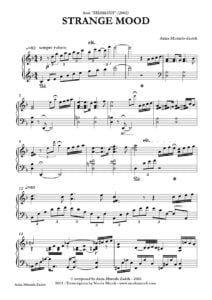 |
|
| Aziza Mustafa Zadeh – Dreaming Sheherezadeh |
 |
|
| Aziza Mustafa Zadeh – Melancholic Princess |
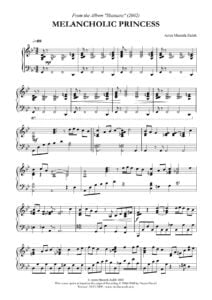 |
|
| Aziza Mustafa Zadeh – Barabashka |
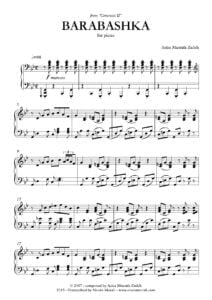 |
|
| Aziza Mustafa Zadeh Two Candles |
 |
|
| B Witched – Cest La Vie | ||
| B Witched – Rollercoaster | ||
| B. B. King Live At The Regal Guitar TAB |
 |
B. B. King Live At The Regal Guitar TAB |
| B.B. King Anthology Guitar TAB |
 |
B.B. King Anthology Guitar TAB |
| B.B. King Greatest Hits |
 |
B.B. King Greatest Hits |
| B.B. King Guitar Play Along Vol. 100 – with MP3 audio embedded with Tablature |
 |
Guitar Play Along Vol. 100 – B.B. King |
| B.B. King The Definitive Collection Guitar Signature Licks with TABs By Wolf Marshall |
 |
B.B. King The Definitive Collection Guitar Signature Licks By Wolf Marshall_compressed |
| Baby Elephant Walk (Hatari OST) Henry Mancini | ||
| Baby Elephant Walk Mancini (Musescore File).mscz | ||
| Babyface, The Songs Of (Kenneth Brian Edmonds) |
 |
Babyface, The Songs Of (Kenneth Brian Edmonds) |
| Bach – Jesu Bleibet Meine Freude Guitar arr.mscz | ||
| Bach – Siciliano In G Minor (Musescore File).mscz | ||
| Bach – Siciliano in G minor Piano solo (Intermediate) |
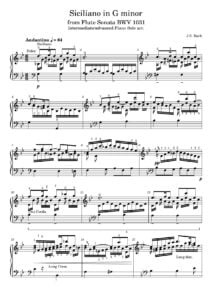 |
|
| Bach J.S. – Aria Mit Variationen Goldberg Variationen Bwv 988 Mit Noten – Sheet Music (Musescore File).mscz | ||
| Bach J.S. – Orchestral Suite No. 1 In C Major Bwv 1066 Passepied (Easy Piano Solo) (Musescore File).mscz | ||
| Bach J.S. For Bass Guitar Mel May Publications |
 |
|
| Bach – Analysis of J.S. Bach’s Wohltemperirtes clavier (48 preludes & fugues) ( Book ) Riemann |
 |
|
| Bach – Arioso (Musescore File).mscz | ||
| Bach – Cello Suite No. 1 In G Major Bwv 1007 Arr. Guitar (Musescore File).mscz | ||
| Bach – Chaconne Bwv 1004 Guitar Arr. (Musescore File).mscz | ||
| Bach – Easy Pieces for Classical Guitar – Notes & Tablature |
 |
Bach – Easy Pieces pieces for guitar |
| Bach – Kurtag – Transcriptions for piano four hands |
 |
|
| Bach – Masterworks of Johann Sebastian Bach ( Book) |
 |
|
| Bach – Music in the Castle of Heaven by John Eliot Gardiner (Book) |
 |
|
| Bach – Praeludium Et Fuga In D Bwv 539 Piano Solo (Musescore File).mscz | ||
| Bach – Prelude And Fugue In A Minor (Bwv 543) (Musescore File).mscz | ||
| Bach – Sheep May Safely Graze (Schafe Könen Sicher Beiden) Aria From The Cantata Bwv 208 Easy Piano |
 |
|
| Bach – Siciliano (Easy Piano arr. from Flute Sonata BWV 1031 with sheet music) |
 |
|
| Bach – Siciliano (Easy Piano Arr. From Flute Sonata Bwv 1031 With Sheet Music) (Musescore File).mscz | ||
| Bach A Life In Music by Peter Williams (2006) Biography Book |
 |
|
| Bach Baden Powell Jesus Bleibet Meine Freude Guitar Tablature Tabs |
 |
|
| Bach Bourée (Piano Solo) Jethro Tull (Musescore File).mscz | ||
| Bach Busoni Complete Transcriptions |
 |
Bach Busoni Complete Transcriptions |
| Bach Bwv 22 – Sanctify Us By Thy Goodness Piano Arr. Harriet Cohen (Musescore File).mscz | ||
| Bach Cello Suite No. 1 In G Major For Guitar (Musescore File).mscz | ||
| Bach Chaconne BWV 1004 Abel Carlevaro Guitar Masterclass IV |
 |
|
| Bach Chaconne D minor arr. for guitar |
 |
|
| Bach Forty Chorales Arr. For Piano Solo |
 |
|
| Bach Fugue In G Minor Bwv 578 (Piano Solo) (Musescore File).mscz | ||
| Bach Fugue Iv Bwv 849 Wtc I (With Sheet Music Noten) (Musescore File).mscz | ||
| Bach Goedicke – Prelude Fugue BWV 539 transcribed for piano |
 |
|
| Bach Gounod Prelude 1 Ave Maria Jazz Improvisation |
 |
|
| Bach Guitar – Fingerpicking Bach (with Tablature) |
 |
Bach Guitar – Fingerpicking Bach |
| Bach J.S. J.S. – French Suites (I to VI) |
 |
|
| Bach J.S. JS – BWV 208 – Sheep May Safely Graze (arr Friedman) | BACH JS BWV 208 | |
| Bach J.S. Air from Orchestral Suite no. 3 in D Major (trans. D. Weymouth) | Bach J.S. -Air-Weymouth | |
| Bach J.S. Jesu, Joy of Man’s Desiring – Piano Arr Groban, Josh |
 |
|
| Bach J.S. – Jazz Play Along Vol. 120 Pdf + Mp3 Audio Tracks |
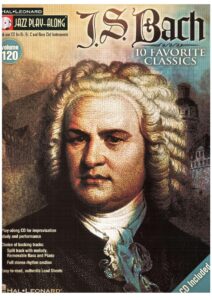 |
Jazz_Play_Along_Vol_120_-_J_S_Bach |
| Bach J.S. – Air on a G String |
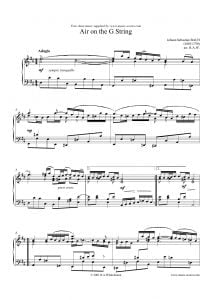 |
|
| Bach J.S. – Busoni Chaconne (piano solo arr.) |
 |
|
| Bach J.S. – BWV 565 Piano – Toccata E Fuga In Re Min | Bach – Bwv 565 Piano – Toccata E Fuga In Re Min | |
| Bach J.S. – Cantata BWV 147 – Coral ‘Jesus Bleibet Meine Freude’ (Easy Piano Solo) | Bach Jesu Joy Of Mans Desiring Cantata Bwv.147 Piano Solo Page 1 Of 5 | |
| Bach J.S. – Das Wohltemperierte Klavier HENLE VERLAG |
 |
|
| Bach J.S. – Easy Pieces for Classical Guitar – Notes & Tablature |
 |
Bach – Easy Pieces pieces for guitar |
| Bach J.S. – English Suites Inglesi (piano) BWV 806-811 |
 |
|
| Bach J.S. – Nun komm, der Heiden Heiland, BWV 659 | Bach, J.S. – Nun komm, der Heiden Heiland, BWV 659 | |
| Bach J.S. – Toccata and Fugue in D minor BWV565 (Piano solo arr. Grainger) |
 |
|
| Bach J.S. – Two Part Inventions Busoni |
 |
|
| Bach J.S. – Well-Tempered Klavier Analysis Part II Dr. H. Riemann |
 |
|
| Bach J.S. – Wilhelm Kempff 10 Bach Transcriptions for piano |
 |
Kempff – 10 Bach Transcriptions |
| Bach J.S. (H Bauer) – Corale Dalla Cantata no. 147 “Jesu, Joy of man’s desiring” BWV 7 (Piano Solo) |
 |
|
| Bach J.S. (Marcello) – BWV 974 -Adagio | Bach (Marcelo) – BWV 974 -Adagio | |
| Bach J.S. 12 Small Preludes |
 |
|
| Bach J.S. 15 Three-voice Inventions |
 |
|
| Bach J.S. 15 Two part Inventions Pure Text Ed. Allan Peterson |
 |
|
| Bach J.S. 6 Partitas( I to VI) |
 |
|
| Bach J.S. AIR ON THE G STRING ARR. SILOTI |
 |
|
| Bach J.S. ARIA SUITE EN RE (arr. for 2 PIANOS) | Bach ARIA SUITE EN RE 2 PIANOS | |
| BACH J.S. Art Fugue Die Kunst der Fuge (Ed. Czerny ) BWV 1080 |
 |
|
| Bach J.S. Art Of Fugue Czerny (Ed. Kalmus) BWV 1080 |
 |
|
| Bach J.S. Busoni BWV564 | ||
| Bach J.S. BWV 1055 keyborad concerto n 4 | ||
| Bach J.S. BWV 971 Italian Concerto | ||
| Bach J.S. Cantata 147 arr. for Easy piano solo | Bach-Jesu-Joy-of-Mans-Desiring-Cantata-BWV.147-Piano-Solo | |
| BACH J.S. CANTATA 22 ARR. PIANO SANCTIFY US BY THY GOODNESS arr. by Harried Cohen |
 |
Besides his clearly insightful listening, the primary sources for the analyses are Waters’s effective and extensive transcriptions of the compositions and improvisations (there are 63 musical examples). Waters also cites a broad cross-section of literature about the quintet, its members, and these compositions, as well as larger issues in jazz studies. He also refers extensively to Library of Congress sources (Wayne Shorter’s copyright deposits), extant lead sheets, and interviews.
This is an extremely thorough, in-depth, and insightful analytical study. It is a major addition to the field of jazz studies for a variety of reasons. First, it gives us minutely detailed and skillful analyses of these wonderful and innovative recordings. These sessions present essential compositions from the band members, including of course Wayne Shorter, one of jazz’s great composers—particularly for small group writing—and Herbie Hancock.

Waters also puts forth his notion of how to analyze jazz solos, an area still in its relative infancy and rife with slippery slopes. He also makes a successful foray into issues of group interaction, an area that has drawn much attention in the field of jazz studies, including writings by Ingrid Monson, Paul Berliner, and Robert Hodson.
Perhaps most importantly, while employing his analytical and theoretical skills and drawing on the strengths, vocabulary, and methodology of the field of music theory, Waters also manages to convey how jazz musicians generally think and speak about music without feeling the necessity to contextualize these assumptions within traditional music theory models. For example, he unapologetically speaks of an essential element in jazz, the use of complex and colorful chords with chord tones above the seventh.
These chords and chord tones can be manipulated in innumerable ways and are part of the standard jazz harmonic vocabulary; they do not need explaining or rationalizing, or, for that matter, resolving. For example,
rather than conceiving of the ninth as a consonant chord tone that has a myriad of voice-leading possibilities, the music theory orthodoxy at times imposes its traditional tonal approach on jazz by referring to this tone as a dissonance in need of resolution. Waters has brought in the practitioner’s perspective, and feel that this is an important and much-needed advance in the field of jazz studies and, more specifically, music theory and analysis as it relates to jazz.
This approach more clearly articulates composers’ and players’ practical application of complex chords. Jazz and pop scholarship—the two often tend to intertwine—is a relatively young field that is rapidly gaining theoretical maturity.
Within it, from a gross standpoint, are two streams, cultural and analytical. In his preface, Waters speaks to his perception of such a split in the jazz community: “Jazz studies has profited considerably by recent intersections with cultural studies… Yet occasionally such studies critique other approaches that allow more detailed views of musical organization, structure, and theorizing about them”.
Waters seems to be heading off in advance what he perceives to be unnecessary criticism of his approach.
Though he has created theoretical models, such as the six levels of form in improvisation, Waters explicitly stakes out ground for “analysis for analysis’s sake,” independently of these models. And while this book is firmly rooted in the music theory world, it also reaches well beyond it, speaking to all jazz musicians regardless of training or familiarity with music theory literature and vocabulary.
Only occasionally are there analyses employing traditional music theory models that are a slight stretch in this context. For example, at times his claims of long-range voice-leading maneuvers over the course of a solo do not reflect the aural effect as I perceive it and seem to imply an intention that I do not believe is present.
Waters looks at these recordings holistically—examining the overall forms,
including the improvisations—and then closely analyzes both the head and improvisations for issues such as harmonic content, motive (or what he calls “a rather general and loose notion of motive” [xiv]), form, and meter (including hypermeter), bringing a unique analytical perspective to each. Some analysts have focused on particular solos, while others concentrate on formal compositional issues; Waters, on the other hand, examines an admirably broad range of analytical topics.
He seems most comfortable when writing about Hancock’s and Shorter’s compositional and improvisational strategies. He also examines Miles’s contributions, of course, but the trumpeter’s overall presence as a player and bandleader should feel much larger than it does in the book.
Williams’s contributions, while acknowledged as vast, are sorely overlooked here. Even without transcriptions—a drastic omission by the author’s own admission— the drummer’s role could have been examined in much more detail. While more attention is paid to Carter than to Williams, the bassist’s presence here is also much smaller than I would expect or hope.
Hancock’s role is certainly emphasized, which is understandable given Waters’s inclinations and the pianist’s pivotal role in the band. Clearly, Waters has chosen to focus on the issues that are important to him, but these biases are big issues for me. In my opinion, Miles is the most important member of this group on many levels, and Williams is next in line.
So obviously we have a different perspective. After the preface, the book is logically and neatly divided into eight chapters. The first examines the quintet itself, its studio processes and personnel. Chapter 2 gives an extremely detailed description of analytical techniques employed throughout the book. Chapters 3 to 6 examine one album each—E.S.P., Miles Smiles, Sorcerer, and Nefertiti—while chapter 7 tackles Miles in the Sky and Filles de Kilimanjaro. The final chapter examines the legacies of the quintet.
Chapter 1 contextualizes the group, which Waters position as a link between hard bop practices and the avant-garde. Regarding the group’s compositional impact, Waters states, “The compositions themselves represent a significant contribution to the jazz repertory, and their innovations form a cornerstone of contemporary jazz composition”.
He substantiates this claim by discussing elements such as chord types employed, chord successions, non-functional progressions, motivic development, and a determined deviation from standard forms.
Waters also introduces the studio processes of the band, which play an important role throughout the book and add a much-appreciated practical point of view. In the process, Waters debunks Miles’s reputation as a “one-take” artist by closely examining alternate takes. Waters provides detailed discussions of the evolution of each work through the rehearsal process, including comparisons between the recordings and Shorter’s lead sheets, and builds upon what we generally know of these recordings from writers such as Todd Coolman, Jack Chambers, Ian Carr, and John Szwed.
Chapter 2 provides a detailed overview of the analytical strategies employed throughout the book, and Waters takes advantage of this opportunity to address major issues in jazz analysis. For example, he tackles the ambiguous term “modal jazz” and lays out various complexities and approaches to the style, in relation to both Miles’s recordings and jazz more generally. After historically contextualizing the style, Waters analyzes the quintet’s use of “modal harmony” in depth, as well the members’ approach to mode/scale improvisation.
Motivic analysis plays a major role in Waters’s analyses of both the compositions and the solos. He states that he examines motivic development less to find cohesion and unity in improvisations than to provide “ways to help hear how these players worked out individual ideas during the flow of improvisation”. His analyses, however, often feel more like a discussion of a composition, highlighting the difficulty of analyzing improvisational material.
After a brief contextualization, he parses the discussion into three basic areas: the use of motivic cells, the interaction of motivic material between players, and the expansion of motivic material. Another major methodology employed by Waters examines rhythm and phrase structure to discuss meter, hypermeter, and metrical conflict in improvisation.
Waters speaks of four basic methods here: elasticizing harmonic rhythm, the shifting of accents to create metrical ambiguity, metrical conflict, and the creation of formal ambiguity through the blurring of formal divisions.
This analytical introduction concludes with Waters’s theory of form in improvisation, which looms large throughout this study.
He has created this useful system to categorize various approaches to “free” improvisation and “provide a more nuanced view of formal solutions and attitudes in the 1960s, one that more richly describes formal practice and that more closely acknowledges the band’s notion of ‘controlled freedom’”.
He has classified levels of form in improvisation, ranging from Level 3—where the rhythm section and soloist preserve hypermeter, meter, pulse, harmonic progression, and harmonic rhythm from the head—to Level 0, where the soloist and rhythm section essentially abandon these elements (Levels 1 and 2 are subdivided to make six levels altogether).
In the following chapters, which examine the albums chronologically, Waters introduces each album as a whole and then proceeds to each composition. After an introduction to the track, he generally chooses one or two primary analytical areas to focus on. One of the great strengths of the book is that he manages to cover an extensive range of issues while also employing a wide array of analytical techniques.
Each analysis is deep and detailed and allows—indeed requires—intense study. Throughout, Waters contextualizes the compositions, giving us a feel for the composers’ styles and compositional evolution, as well the group’s evolving compositional approach. For example, Waters points out that Hancock’s “Little One,” from E.S.P., is an important composition for the group harmonically, as the pianist explores shifting harmonies over bass pedal points, a significant stylistic element for Hancock and the group. Waters does not contextualize the players’ improvisations as effectively, however, and this is a rich avenue for further study.
Waters does, however, provide a model for this technique in an analysis of Shorter’s solo on “Pinocchio”. Hancock’s and Shorter’s harmonic conceptions were essential to the character of these recordings, as well as to the future of jazz, and in his discussion of “Little One” Waters provides valuable insight into Hancock’s harmonic sensibilities as a
composer.
Loosely and freely borrowing from a Schenkerian perspective, Waters examines the composition’s bass line from a large-scale perspective. He then discusses the tune’s intensely colorful chromatic progressions in close detail from a mode/scale perspective, pointing out that the progressions generally rely upon principles of tritone substitutions but in a fascinating permutation.
For this recording, however, Waters primarily examines Miles’s solo, initially discussing his handling of a Fsus4 chord in terms of scales and modes. While Shorter and Hancock avoid the third in their solos, “Davis’s solo offers a study in how he negotiates and reevaluates that harmony in real time over the course of his three choruses. It suggests a remarkably rapid learning curve in adapting to that harmony, and altering the harmonic implications of the opening 4 bars in each chorus”. This is an engaging examination of a soloist’s thought process and his journey through an improvisation.
Waters also uses this solo to make an important observation regarding the limitations of mode/scale analysis: “Davis seems unconcerned with careful negotiations of each individual harmony. Instead, the solo attains much of its expressive power through memorable and malleable motives”. Waters’s discussion of Miles’s use of motives is perceptive and detailed, yet I feel he does not quite manage to convey the actual character of the solo. I found myself longing for more adjectival writing that attempts to express the beauty, excitement, and other intangibles that make a solo, soloist, or composition special.
Waters has shown himself quite capable of doing so, but seems a bit reticent in this regard. For example, in this solo, I find myself completely enthralled by Miles’s careful and extremely colorful pitch choices as he floats over this knotty and complicated harmonic progression, though it clearly presents him with a bit of difficulty. Also, his ability to make the strange melody he creates seem natural and melodic— almost as if he is playing “Bye, Bye Blackbird”—is essential to his style and appeal.
Waters alludes to this when he states, “Davis seems uninterested in negotiating and expressing each harmony carefully…”, but he does not capture Miles in the analysis as I hear him. Davis’s lyrical quality and melodic gift are not discussed, nor is the enigmatic yet unmistakable emotional content of his work. So again, Davis’s impact on this music is not nearly as significant in Waters’s overall analysis as I feel it deserves to be.
Thankfully Waters does not support the wildly faulty and often-discussed notion that Miles was a limited trumpet player technically. But Waters also says little to refute this idea. Davis in fact became a wonderful player, as evidenced by his magnificent work as featured melodist and soloist on studio recordings such as Birth of the Cool and the albums with arranger Gil Evans. Additionally, on the recordings discussed in this book, his solos are, in my listening, the most direct and musically and emotionally compelling. Unfortunately, Waters’s writing does not convey Miles’s brilliance, his level of musicianship, or the sound that has captivated
me for so many years.
This does not apply to Hancock’s playing, however, and Waters’s analysis of Hancock’s “Madness” from Nefertiti is a prime example. The CD set of the complete studio recordings of the quintet includes alternate takes that give us added insight into the workings of this group, and for “Madness” there is also a rehearsal take.
For the rehearsal, they play the tune as a slow waltz in two sections—evidently Hancock’s original conception of the piece—while the released take and alternate takes are in a quick 4/4 with only one section.
After a brief discussion of the form, Waters analyzes the head of the released take, which consists of six chords/harmonies, all rich and colorful. The fifth, however, cannot be labeled with a traditional chord name, and Waters solves this dilemma by naming it the “Madness” chord (he does this elsewhere with the “Riot” chord, also on Nefertiti). The “Madness” chord consists of a B in the bass, left-hand pitches A3-C4-Eb-Ab, and right-hand pitches B-D-D#-E/Fb.
Naming the chord is only the first problem, and Waters goes on to relate it to doubly diminished harmonies (simultaneous diminished seventh chords a half step apart) used by Hancock. This proves problematic, as he points out, because the chord, combined with the six-note melody stated by the horns, employs eleven of the twelve chromatic pitches.
Though all of Waters’s analyses are cogent and insightful, I cannot help but feel that he is most at home when discussing Hancock’s playing. He offers a detailed analysis of Hancock’s “Madness” solo, declaring it “an improvisational tour de force.” I greatly appreciate Waters’s overview of what makes this solo so exceptional.
He discusses an array of issues such as group interaction, and the freedom
from meter and hypermeter while maintaining a sense of pulse (Level 1 in his scheme of form in improvisation). Waters then details Hancock’s navigation through three cycles of the six-chord progression, focusing on his use of the diminished scale (octatonic collection).
Fortunately, in this solo analysis, Waters has a brief yet solid section that addresses the rhythm section’s improvisational strategies, which are crucial to this tune. In this case, however, a more thorough analysis of the drums and bass would be quite illustrative and helpful in conjunction with the harmonic analysis of Hancock’s solo. It would also help explore more deeply the “controlled freedom” that this group was so intently developing. In the case of Williams, for example, a discussion of his cymbal patterns (a crucial element in his playing and influence)—
as well as the dynamics, colors and orchestration aspects of the drum kit—would have proved useful.
This is another important area for future study. Waters’s approach to “Pinocchio,” also from Nefertiti, shows off another of his analytical strengths—his insight into Wayne Shorter’s compositional style, including
contextualization of his composing and playing in relation to his past work.
In chapter 2, Waters discusses Shorter’s use of motivic expansion in his solo on “Orbits,” from Miles Smiles, and notes that in “Pinocchio” these principles carried over into his composing. In the analysis of “Pinocchio” he traces the main motive as it expands throughout its three statements while also transforming harmonically, and contrasts this with Shorter’s earlier reliance upon “motives that recur at regular 2-bar intervals”.
Shorter’s solo on “Pinocchio” is then parsed into five sections, each introducing new motivic material. Waters also points out connections between these sections, stating for example that “As Shorter initiates new motivic ideas every 8 bars, the pitch material at Sections 3 and 4 emanates from the pitches stated just previously.
This illustrates a compelling improvisational tactic in which events flow out of preceding material and suggests that soloists establish musical relationships and continuity not only from overt motivic correspondences, but also from pitch relationships that then launch new motivic ideas”. While Waters makes a strong argument for the tactic in this particular case, further exploration is needed to support his broader claim that it is a feature in other soloists’ improvisations.
As he does elsewhere, Waters points out discrepancies between The Real Book (the most prominent “fake book” used by musicians) and the recording, noting that some previous analyses have relied on incorrect lead sheets. In a quick but fascinating examination, he adds that while the fake book changes appear to be more tonally functional at first, the actual changes on the recording are actually more functional upon closer inspection. His analysis is steeped in both the functional harmony and jazz tradition, and his language is understandable to anyone with either theoretical or practical experience—a rare combination in works of this sort.
He manages to blend his jazz musicianship and his analytical chops in an unusually effective manner—another indication of the value of this book as it both corrects and builds upon past work on this material.
The Studio Recordings of the Miles Davis Quintet, 1965-68 advances the field of jazz analysis through its thoroughness and analytical insight, applying creative approaches to explain music that has often seemed structurally opaque and mysterious and that has often been discussed only in superlatives. This study has few counterparts for comparison and stands in a rather lonely position in the world of contemporary jazz analysis.
ABOUT THE CONTRIBUTOR
BENJAMIN BIERMAN is a composer, trumpeter, bandleader, and assistant professor at John Jay College, CUNY. He has published articles in Jazz Perspectives and American Music Review, and has contributed essays to the book Pop- Culture Pedagogy in the Music Classroom as well as the forthcoming The Cambridge Companion to Duke Ellington.
Download Miles Davis’ sheet music and play along books from our Library.
Miles Davis – Kind Of Blue (Full Album)
00:00 – So What 12:16 – Freddie Freeloader 22:03 – Blue in Green 27:42 – All Blues 39:15 – Flamenco Sketches
Browse in the Library:
| Artist or Composer / Score name | Cover | List of Contents |
|---|---|---|
| (500) Days Of Summer Piano Theme ( Mychael Danna, Rob Simonsen) | (500) Days Of Summer Piano Theme ( Mychael Danna, Rob Simonsen) | |
| 10,000 Maniacs Because The Night Piano Solo sheet music |
 |
|
| 100 Golden Standards The World’s Best Piano Arrangements by the greatest pianists of the Century |
 |
The World’s Best Piano Arrangements |
| 100 Great Keyboard Intros Songbook |
 |
100 Great Keyboard Intros Songbook |
| 100 Greatest Film Scores (Book) by Matt Lawson & Laurence E. MacDonald |
 |
|
| 100 greatest POP songs |
 |
100 greats pop songs |
| 100 Greatest Songs of Rock & Roll, Selections From Piano Vocal Guitar Sheet Music |
 |
100 Greatest Songs of Rock & Roll, Selections From Piano Vocal Guitar Sheet Music |
| 100 Hits Simply The Best – Guitar (Die besten Songs aus Pop Rock) German |
 |
100 Hits Simply The Best (Die besten Songs aus Pop |
| 100 Jazz & Blues Greats Book |
 |
100 Jazz & Blues Greats |
| 100 Jazz Solos & Etudes by Jacob Wise |
 |
100 Jazz solos |
| 100 Light Classics For Piano Solo |
 |
100 Light Classics For Piano Solo |
| 100 Most Beautiful Christmas Songs Easy Piano Vocal |
 |
100 Most Beautiful Christmas Songs Easy Piano Vocal |
| 100 Most Beautiful Christmas Songs Piano Vocal Guitar |
 |
100 Most Beautiful Christmas Songs Piano Vocal Guitar |
| 100 Must-Know Jazz Tunes with MP3 audio tracks to Play Along |
 |
100 Must-Know Jazz Tune – C version |
| 100 of the Best Movie Songs Ever! Piano Vocal Guitar |
 |
100 best movie songs 1&100 best movie songs 2 |
| 100 Of The Best Songs Ever For The Keyboard by Daniel Scott |
 |
100 Of The Best Songs Ever For The Keyboard |
| 100 Piano Solos (100 popular standards of today arr. by Frank Booth) with guitar chords |
 |
100 piano solos 1 |
| 100 Pop Hits Of The 90’s by Dan Coates |
 |
100 Pop Hits Of The 90’s by Dan Coates |
| 100 Rock N Roll Standards Piano Vocal Guitar chords |
 |
100 Rock N Roll Standards Piano Vocal Guitar chords contents |
| 100 Songs For Kids – Easy Guitar Lyrics with Tablature |
 |
100 Songs For Kids – Easy Guitar Lyrics |
| 100 Tunes Every Musician Should Know Professional Chord Changes And Substitutions By Dick Hyman |
 |
100 Tunes Every Musician Should Know Professional Chord Changes And Substitutions By Dick Hyman |
| 100 Ultimate Blues Riffs For Piano Keyboards |
 |
100 ultimate riffs jazz piano |
| 100 Women Of Pop And Rock 100 songs by 100 artists |
 |
100 Women Of Pop And Rock 100 songs by 100 artists Piano Vocal Guitaral Leonard |
| 100 Years Of Popular Music 1980s Part Two Piano Vocal Guitar Chords |
 |
100 Years Of Popular Music 1980s Part Two Piano Vocal Guitar Chords |
| 1000 Examples of Musical Dictation (Ladukhin, Nikolay) | 1000 Examples of Musical Dictation | |
| 1000 Words – Final Fantasy X-2.mscz | ||
| 1001 Blues Licks by Toby Wine – Piano |
 |
1001 Blues Licks by Toby Wine – Piano |
| 1001 Jazz Licks A Complete Jazz Vocabulary For The Improvising Musician (Jack Shneidman) |
 |
1001 Jazz Licks A Complete Jazz Vocabulary For The Improvising Musician (Jack Shneidman) |
| 101 Cançoes Que Tocaram O Brasil Nelson Motta (Book) (Brazilian Portuguese) |
 |
|
| 101 Frank Sinatra Hits For Buskers |
 |
101 Frank Sinatra Hits For Buskers |
| 101 Mississippi Delta Blues Fingerpicking Licks Guitar and TAB by Larry McCabe |
 |
Larry McCabe – 101 Mississippi Delta Blues Fingerpicking Licks |
| 101 Must-Know Blues Licks (Guitar Educational) (Wolf Marshall) PDF + MP3 audio tracks Play Along with Tablature |
 |
101 Must-Know Blues Licks (Guitar Educational) (Wolf Marshall) |
| 1015 Songs – The Original Musicians’s (Musicals) |
 |
1015 Songs – The Original, Musicians’s (Musicals) |
| 106 Songs Everybody Plays |
 |
106 Songs Everybody Plays |
| 11 Short Classical Piano Pieces |
 |
11 Short Classical Piano Pieces |
| 116 Arrangements Of Baroque, Classical & Ballet Pieces For Piano Solo |
 |
116 Arrangements Of Baroque, Classical & Ballet Pieces For Piano Solo |
| 129 Easy Pieces For Piano Solo, also for beginners |
 |
129 easy pieces for piano solo |
| 12th Street RAG – Liberace Collection Book of 5 compositions |
 |
 |
| 12th Street Rag by Euday Bowman (Piano Solo sheet music, Noten, partition, partitura, spartito).mscz | ||
| 150 Best Songs For Acoustic Guitar |
 |
|
| 150 More Of The Most Beautiful Songs Ever (Songbook) Piano Vocal Guitar |
 |
150 More Of The Most Beautiful Songs Ever (Songbook) Piano Vocal Guitar |
| 150 Of The Best Jazz Standards Ever |
 |
150 Of The Best Jazz Standards Ever |
| 150 Of The Most Beautiful Songs Ever 3rd Edition |
 |
150 Of The Most Beautiful Songs Ever 3rd Edit1 and 150 Of The Most Beautiful Songs Ever 3rd Edit2 |
| 16 Pop and Movies Hits Keyboard Piano Book (Mike Emerson) |
 |
16 Pop and Movies Hits Keyboard Piano Book (Mike Emerson) |
| 1600 Pennsylvania Avenue The Musical By Leonard Bernstein And Alan Jay Lerner Vocal Selections |
 |
|
| 17 Moments of Spring – Mgnovenia (Mikael Tariverdiev) | ||
| 1812 Overture Op. 49 Thaikovsky (arr. piano solo) |
 |
|
| 1950s Jazz (Fake Book lead sheet music) |
 |
1950s Jazz (Fake Book lead sheet music) |
| 20 Century Fox Theme Transcription By Deusde Coppen |
 |
|
| 20 Modern BEBOP Licks – by Noah Kellman All Keys with left hands chords |
 |
20 Modern BEBOP Licks – by Noah Kellman All Keys with left hands chords |
| 200 Jazz Standards Tunes (chords progressions for C Instruments) Bob Taylor |
 |
200 Jazz Standards Tunes (chords progressions for C Instruments) Bob Taylor |
| 200 Of The Best Songs From Jazz Of The ’50s | jazz of the 50s | |
| 2014 Top Hits Of 2014 Songbook Piano Vocal Guitar |
 |
2014 Top Hits Of 2014 Songbook Piano Vocal Guitar |
| 2016 Top Hits Of 2016 Songbook Piano Vocal Guitar |
 |
2016 Top Hits Of 2016 Songbook Piano Vocal Guitar |
| 2018 Greatest Pop Movie Hits Songbook For Piano |
 |
2018 Greatest Pop Movie Hits Songbook For Piano |
| 2019 GREATEST POP MOVIE HITS SONGBOOK FOR PIANO PART 2 Piano sheet music (Jim Presley) |
 |
2019 GREATEST POP MOVIE HITS SONGBOOK FOR PIANO PART 2 Piano sheet music (Jim Presley) |
| 2020 Greatest Pop Piano Sheet Music Book Songbooks For Piano |
 |
2020 Greatest Pop Piano Sheet Music Book Songbooks For Piano |
| 20th Century Classics Volume 1 |
 |
20th Century Classics Volume 1 |
| 20th Century Jazz Guitar by Richie Zellon (with Tablature) |
 |
20th Century Jazz Guitar by Richie Zellon |
| 20th Century Masters Of Fingerstyle Guitar by John Stropes |
 |
20th Century Masters Of Fingerstyle Guitar by John Stropes |
| 20th Century Piano Music – Book (1990) David Burge |
 |
20th Century Piano Music Book (1990) David Burge |
| 24 Etudes Op.35 – Fernando Sor (1778 – 1839) (Musescore File).mscz | ||
| 24_Preludes_Op.34 Shostakovich.mscz | ||
| 25 Short Classical Guitar Pieces (with Tablature) |
 |
25 Short Classical Guitar Pieces |
| 262 Classic Piano Rags Various Composers |
 |
262 Classic Piano Rags Various Composers |
| 273 Easy And Intermediate Piano Pieces |
 |
273 Easy And Intermediate Piano Pieces contents |
| 28 Modern Jazz Trumpet Solos Book 2 |
 |
28 Modern Jazz Trumpet Solos Book 2 |
| 3.10 to Yuma (Marco Beltrami) | ||
| 30 Best Rock Guitar Songs Ever (Guitar TABs) |
 |
30 Best Rock Guitar Songs Ever (Guitar TABs) |
| 300 Sacred Songs Melody Lyrics Chords Fake Book Melody Lyrics Chords |
 |
300 Sacred Songs Melody Lyrics Chords Fake Book Melody Lyrics Chords_compressed |
| 36 Christmas Carols Songs |
 |
36 christmas carols songs |
| 38 Special Guitar Anthology Guitar Recorded Vers. with Tablature |
 |
38 special guitar anthology |
| 39 Progressive Solos For Classical Guitar (with Tablature) |
 |
39 Progressive Solos For Classical Guitar |
| 39 Progressive Solos For Classical Guitar Book 2 (with Tablature) |
 |
39 Progressive Solos For Classical Guitar Book 2 sheet music pdf |
| 40 Easy Guitar Pieces (Painted with the Sound) |
 |
|
| 49 Most Popular Jazz Songs |
 |
49 Most Popular Jazz Songs |
| 5 Christmas Songs Sheet Music Trumpet in B & Piano accompaniment (Viktor Dick) | 5 Christmas Songs Sheet Music Trumpet in B & Piano accompaniement (Viktor Dick) | |
| 50 Broadway Shows 50 Broadway Songs |
 |
50 Broadway Shows 50 Broadway Songs |
| 50 Classical Guitar Solos In Tablature (Howard Wallach) with Tablature |
 |
50 Classical Guitar Solos In Tablature (Howard Wallach) |
| 50 Essential Bebop Heads Arranged For Guitar Tablature (best lines Charlie Parker, Dizzy Gillespie, Thelonious Monk and more) |
 |
50 Essential Bebop Heads Arranged For Guitar Tablature (best lines Charlie Parker, Dizzy Gillespie, Thelonious Monk and more) |
| 50 Jazz Standards Every Jazz Musician Needs To Know with MP3 audio tracks to Play Along |
 |
50 Jazz Standards Every Jazz Musician Needs To Know – C version |
| 50 Most Popular Classical Melodies (Easy Piano) |
 |
50 Most Popular Classical Melodies |
| 50 Of The Most Beautiful Piano Love Songs Solos Ever. |
 |
50 OF THE MOST BEAUTIFUL PIANO LOVE SONGS SOLOS EVER |
| 50 Piano Arrangements Of Hymns And Gospel Songs (Fred Bock’s Best) |
 |
50 Piano Arrangements Of Hymns sheet music |
| 50 Piano Classics – Easy |
 |
50 piano classics |
| 50 Riffs For Blues Guitar – Martin Shellard with MP3 audio to Play Along with Tablature |
 |
50 riffs for blues guitar |
| 500 Piano Intros For The Great Standards – Steinway |
 |
500 piano intros |
| 55 Country Classics (Voice, piano, Guitar) |
 |
55 Country Classics (Voice, piano, Guitar) |
| 557 Jazz Standards (Sheet Music – in C for all instruments) swing to bop (lead sheet) |
 |
Standards (Sheet Music – Piano) |
| 60 Progressive Solos For Classical Guitar By Mark Phillips (with Tablature) |
 |
|
| 67 Fun Songs arranged by Jon Schmidt (Piano) |
 |
|
| 70’s Hits (Easy Piano Solos) – Hans-Gunter Heumann [Piano, Vocal, Chords] |
 |
 |
| 750.000 anni fa.l’Amore (Banco del Mutuo Soccorso) | ||
| 75th Anniversary A Tribute In Music From The 20s Through The 90s Various Artists Warner Bros |
 |
75th Anniversary A Tribute In Music From The 20s Through The 90s Various Artists Warner Bros |
| 78 Quarterly No 1 and 2 (1967) Book magazine |
 |
|
| 8 ½ Theme (Nino Rota) | ||
| 8 Femmes (Krishna Levy) | ||
| 8 Jazz scales you need to know.mscz | ||
| 80 Most Requested LDS Songs (Mormon music) |
 |
80 Most Requested LDS Songs (Mormon music) |
| 88 Piano Classics For Beginners – David Dutkanicz |
 |
88 Piano Classics For Beginners – David Dutkanicz |
| 88 The Giants Of Jazz Piano by Robert L. Foerschuk (Book) foreword by Keith Jarrett |
 |
|
| 9 easy guitar pieces – Sveinn Eythorsson |
 |
|
| 97 Oeuvres pour Guitare de Jean Francois DELCAMP |
 |
97 Oeuvres pour Guitare de Jean Francois DELCAMP |
| 99 Easy Piano Pieces |
 |
99 Easy Piano Pieces |
| A Beautiful Mind – A Kalidoscope of Mathematics |
 |
|
| A Beautiful Mind – All Love Can Be | A Beautiful Mind – All Love Can Be | |
| A Beautiful Mind – Kalidoscope | ||
| A Child Is Born – Oscar Peterson (Musescore File).mscz | ||
| A Chordal Concept For Jazz Guitar by Peter O’Mara |
 |
A Chordal Concept For Jazz Guitar by Peter O’Mara |
| A Ciascuno il Suo (Luis Bacalov) | ||
| A Clare Benediction – John Rutter – Piano Solo Arr. (Musescore File).mscz | ||
| A Clockwork Orange (Beethoviana) | A Clockwork Orange (Beethoviana) | |
| A Clockwork Orange (Beethoviana) (Musescore File).mscz | ||
| A Comparative Study Of The 24 Preludes Of A. Scriabin And Sergei Rachmaninoff (book) |
 |
|
| A Complete Course of Instruction For The Piano-Forte (Dr Karl Merz) (1885) |
 |
Instruction… |
| A Cool Yule. Ten Jazzy Christmas Songs |
 |
A Cool Yule. Ten Jazzy Christmas Songs |
| A Creative Approach To Jazz Piano Harmony Bill Dobbins |
 |
A Creative Approach To Jazz Piano Harmony Bill Dobbins |
| A Creative Approach To Practicing JAZZ – by David Baker |
 |
A Creative Approach To pravtising Jazz |
| A Dance of Dragons – Blood of the Dragon (Game of Thrones) Piano solo arr. |
 |
|
| A Dictionary of Music and Musicians Vol. 4 (A.D. 1450-1880) Edited in 1889 |
 |
“Kind of Blue” is a studio album by American jazz musician Miles Davis, released on August 17, 1959, by Columbia Records. Recording sessions for the album took place at Columbia’s 30th Street Studio in New York City on March 2 and April 22, 1959. The sessions featured Davis’s ensemble sextet, with pianist Bill Evans, drummer Jimmy Cobb, bassist Paul Chambers, and saxophonists John Coltrane and Julian “Cannonball” Adderley.
After the entry of Evans into his sextet, Davis followed up on the modal experimentations of Milestones (1958) by basing Kind of Blue entirely on modality, in contrast to his earlier work with the hard bop style of jazz. Though precise figures have been disputed, Kind of Blue has been described by many music writers not only as Davis’s best-selling album, but as the best-selling jazz record of all time.
On October 7, 2008, it was certified quadruple platinum in sales by the Recording Industry Association of America (RIAA). It has been regarded by many critics as the greatest jazz album of all time and Davis’s masterpiece.
The album’s influence on music, including jazz, rock, and classical music, has led music writers to acknowledge it as one of the most influential albums ever made. In 2002, it was one of fifty recordings chosen that year by the Library of Congress to be added to the National Recording Registry. In 2003, the album was ranked number 12 on Rolling Stone magazine’s list of the 500 greatest albums of all time.
